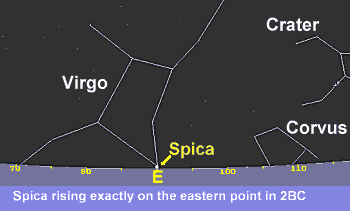 This is a very simple theory. Since Spica would rise every night and cross the sky there is no problem with repeatability or direction. The event is based on a calculations rather than precise observations of the rising star. The star rose exactly in the east and would have appeared at any direction from east, through south, to west every night so would have been seen as the Magi approached Bethlehem at some point during the night. Their joy at seeing the star lay in the fact that it (could have been) lying in the direction of travel towards the house where Jesus was. Spica is a 'star' which is how the Bible describes this event rather than a planet or conjunction or comet or whatever. There is no doubt that it did indeed rise not only in the east - but exactly east.
This is a very simple theory. Since Spica would rise every night and cross the sky there is no problem with repeatability or direction. The event is based on a calculations rather than precise observations of the rising star. The star rose exactly in the east and would have appeared at any direction from east, through south, to west every night so would have been seen as the Magi approached Bethlehem at some point during the night. Their joy at seeing the star lay in the fact that it (could have been) lying in the direction of travel towards the house where Jesus was. Spica is a 'star' which is how the Bible describes this event rather than a planet or conjunction or comet or whatever. There is no doubt that it did indeed rise not only in the east - but exactly east.This theory relies on accurate mathematics and precise calculations. The movement of the point at which a star rises along the horizon is very small. It would take 100 years for it to move along the apparent width of your thumb held at arm's length. It would not have been possible in the 1st century to measure observationally the year by year movement. The shortest amount of time needed to observe a movement would be about 20 to 30 years. So we rely upon Hipparchus' calculations. Hipparchus was a brilliant astronomer and his calculation of the movement was 46 arc minutes a year. (about 1/80th of a degree). The actual movement as calculated today is 50.26 arc minutes. This is such a small difference that it enabled Hipparchus and other astronomers to make all kinds of correct deductions about the movement of the heavens. However it is an error of about 1 year in 10 when it comes to calculating when a star will rise at a certain exact point. If the magi were using Hipparchus' star charts and calculations then the error built up since his death would make the calculated rising 12 years too soon. This error would have caused the rising of Spica on the exact eastern point to have been worked out as something like 20 BC rather than 2BC. The error was within the 20 - 30 years required to notice any movement by observation so I think it unlikely to have been noticed.
To be honest, even if the calculations worked out to an acceptable date, is it acceptable that the time given to the King Herod by the Magi could be described as 'the exact time the star appeared' ? The Greek phaino, means 'appear' in the sense of being seen. There are better Greek words if this is the judgement of a calculation. oiomai, for instance.
The second problem is that modern astronomers have a set co-ordinate system which precisely calculates the exact eastern point. Did the magi use exactly the same co-ordinate system that was used to discover this event on a computer? The ancient and modern eastern points must have been identical to several decimal places in order for this theory to work. .
From a theological point of view the link with astrological symbolism wouldn't have been acceptable to the early church. Moreover the only connection with Old Testament prophecy and this event is Isaiah 7:14 Therefore the Lord himself will give you a sign: The virgin will be with child and will give birth to a son, and will call him Immanuel. . The translation of the Hebrew word 'almah', as 'virgin' is to use the old English meaning of 'a young woman of marriageable age'. Other old English terms like 'maid' or 'damsel', would have been just as appropriate. It is translated as 'virgin' to fit in with its use in Luke's gospel to describe Jesus' mother, Mary. Not only was she 'a young woman of marriageable age' but also a virgin in the technical sense which is important in the gospels. The point being that no one at the time of Jesus birth or before saw Isaiah 7:14 as the prediction of a virgin conception. Therefore, why would the Magi have associated this event as signifying the birth of a Jewish king? It is only with hind sight that Isaiah 7:14 becomes important.
Timing - Unspecific, which both helps and hinders the theory.
Repeatability - No difficulties .
Direction - No difficulties
Theology - Requires hindsight and relies on astrology.
Historic/Scientific credibility - 1st century observation and mathematics not precise enough.
 - Click here to return to the Index.
- Click here to return to the Index. - Click here to return to the Homepage.
- Click here to return to the Homepage. The Theories.
The Theories.